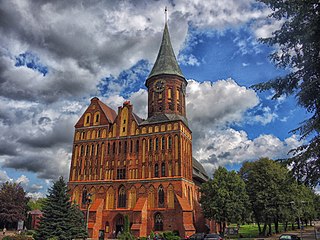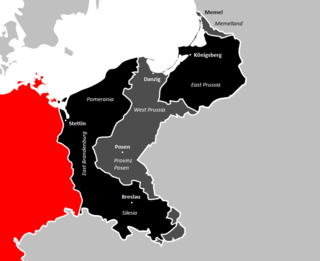
Brandenburg, officially the State of Brandenburg, is a state in northeastern Germany. Brandenburg borders Poland and the states of Berlin, Mecklenburg-Vorpommern, Lower Saxony, Saxony-Anhalt, and Saxony. It is the fifth-largest German state by area and the tenth-most populous, with 2.5 million residents. Potsdam is the state capital and largest city. Other major towns are Cottbus, Brandenburg an der Havel and Frankfurt (Oder).

Masuria is an ethnographic and geographic region in northern and northeastern Poland, known for its 2,000 lakes. Masuria occupies much of the Masurian Lake District. Administratively, it is part of the Warmian-Masurian Voivodeship. Its biggest city, often regarded as its capital, is Ełk. The region covers a territory of some 10,000 km2 which is inhabited by approximately 500,000 people.

East Prussia was a province of the Kingdom of Prussia from 1772 to 1829 and again from 1878 ; following World War I it formed part of the Weimar Republic's Free State of Prussia, until 1945. Its capital city was Königsberg. East Prussia was the main part of the region of Prussia along the southeastern Baltic Coast.

Prussia is a historical region in Central Europe on the south-eastern coast of the Baltic Sea, that ranges from the Vistula delta in the west to the end of the Curonian Spit in the east and extends inland as far as Masuria, divided between Poland, Russia and Lithuania. This region is often also referred to as Old Prussia.

In present-day Germany, the former eastern territories of Germany refer to those territories east of the current eastern border of Germany, i.e. the Oder–Neisse line, which historically had been considered German and which were annexed by Poland and the Soviet Union after World War II. In contrast to the lands awarded to the restored Polish state by the Treaty of Versailles after World War I, the German territories lost with the post-World War II Potsdam Agreement were either almost exclusively inhabited by Germans before 1945, mixed German–Polish with a German majority, or mixed German–Czech with a German majority (Glatz). Virtually the entire German population of the territories that did not flee voluntarily in the face of the Red Army advance of 1945, was violently expelled to Germany, with their possessions being looted and stolen.

The University of Königsberg was the university of Königsberg in Duchy of Prussia, which was a fief of Poland. It was founded in 1544 as the world's second Protestant academy by Duke Albert of Prussia and charted by the King Sigismund II Augustus. It was commonly known as the Albertina and served as a Protestant counterpart to the Catholic Jagiellonian University in Kraków.

The evacuation of East Prussia was the movement of German civilian population and military personnel from East Prussia between 20 January and March 1945, that was initially organized and carried out by state authorities but quickly turned into a chaotic flight from the Red Army.

Neman, is a town and the administrative center of Nemansky District in Kaliningrad Oblast, Russia, located in the historic region of Lithuania Minor, on the steep southern bank of the Neman River, where it forms the Russian border with the Klaipėda Region in Lithuania, and 130 kilometers (81 mi) northeast of Kaliningrad, the administrative center of the oblast. Population figures: 11,798 (2010 Census); 12,714 (2002 Census); 13,821 (1989 Soviet census).

Marion Hedda Ilse Gräfin von Dönhoff was a German journalist and publisher who participated in the resistance against Nazism, along with Helmuth James Graf von Moltke, Peter Yorck von Wartenburg, and Claus Schenk Graf von Stauffenberg. After the war, she became one of Germany's leading journalists and intellectuals, working for over 55 years as an editor and later publisher of the Hamburg-based weekly newspaper Die Zeit.

Princess Elisabeth Ludovika of Bavaria was queen of Prussia as the wife of King Frederick William IV. By birth, she was a Bavarian princess from the House of Wittelsbach; she was related to the ruling houses of Austria and Saxony through the marriages of her sisters. She supported her husband's interests in art and made charitable donations.

Olsztynek is a town in northern Poland, in Olsztyn County, in the Warmian-Masurian Voivodeship. It is the administrative seat of Gmina Olsztynek. It is part of the historic region of Masuria.
The administrative divisions of the German Democratic Republic were constituted in two different forms during the country's history. The GDR first retained the traditional German division into federated states called Länder, but in 1952 they were replaced with districts called Bezirke. Immediately before German reunification in 1990, the Länder were restored, but they were not effectively reconstituted until after reunification had completed.

Mayakovskoye is a rural locality in Gusevsky District of Kaliningrad Oblast, Russia, located on the banks of the Angrapa River. It lies approximately 11 kilometres (7 mi) south-west of Gusev.
Count Christian von Krockow, writing in German as Christian Graf von Krockow, was a German writer and political scientist.

Heimkehrer refers to World War II German prisoners of war and internees—Wehrmacht (Heer), Kriegsmarine, Luftwaffe, Waffen-SS, Ordnungspolizei, behind-the-lines Hiwi security and civilian personnel—who were repatriated to West Germany, East Germany and Austria after the war. Some of the late returnees were convicted war criminals who were subsequently tried in West Germany.

Zernitz station is a former station on the Berlin–Hamburg Railway. The station opened in 1846 and is one of the oldest in the German state of Brandenburg. Originally it was used mainly to connect to the town of Kyritz. Next to the station, which had originally been built on an open field, a settlement subsequently developed that was also called Bahnhof Zernitz or Zernitz-Bahnhof. The station was closed in 1995. The station building, which was built with the original construction of the railway, has heritage protection, as does the burial site of 48 Jewish concentration camp prisoners in the south of the village. They were killed in 1945 when a prisoner transport was accidentally strafed in the station by American low-flying aircraft.

The Brandenburgisches Landeshauptarchiv is the central state archive for the State (Land) of Brandenburg. It is located in Potsdam.

Ruth Leiserowitz is a German historian. Her work and study primarily deal with the wolf children, a group of German children orphaned at the end of World War II in East Prussia. Since 2009, she has been the deputy director of the German Historical Institute in Warsaw. In 2014, she was awarded the Cross of Merit First Class of the Order of Merit of the Federal Republic of Germany by German president Joachim Gauck.
Anti-Lithuanian sentiment is the hostility, prejudice, discrimination, distrust, racism or xenophobia directed against the Lithuanian people, Lithuania or Lithuanian culture. It may also include persecution, oppression or expulsion of Lithuanians as an ethnic group.
The constitution of the state of Brandenburg was adopted as a draft by the state parliament on April 14, 1992, and approved by the population in a referendum on June 14 with 94.04% of the valid votes. Since then, it has been amended seven times, most recently on May 16, 2019.
















